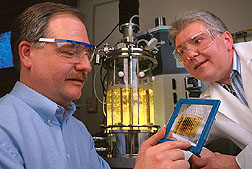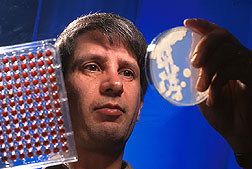Nonfattening Food Additives—From Sugar?
|
|
Many consumers probably don't know that a gum exuded from an African tree species is a key ingredient in their food. Gum arabic from the Acacia tree is used as a thickener and stabilizer in a variety of products, such as citrus-based soft drinks, medicine capsules, and cosmetics.
Because gum arabic prices often fluctuate, food processors want a more reliable domestic substitute—and they may soon have it, thanks to Agricultural Research Service scientists.
The U.S. domestic beet and cane sugar industries, armed with a powerful new strain of a microbe developed by ARS researchers, may someday produce a product called alternan. This alternative to gum arabic could, as a nonfattening food ingredient alone, eclipse the present gum arabic market. The United States buys thousands of tons of gum arabic annually from the Sudan and other countries at volatile prices that are sometimes higher than $5 per pound.
As an emulsifier, gum arabic helps water and food oils mix and stay mixed. Food processors use it in small amounts to make icings stick to cakes, prevent syrups from crystallizing, and maintain a foamy head on a glass of beer—all without changing flavor.
Some gum arabic is used as a bulking agent or filler to provide a desired texture in cosmetics and in industrial products like ink and adhesives.
"We've recently developed ways to produce 100-liter batches of alternan that can be tested as bulking agents in a variety of applications," says Gregory L. Côté. He is an ARS chemist at the National Center for Agricultural Utilization Research (NCAUR) in Peoria, Illinois.
The next goal: Find a way to make alternan that consistently emulsifies at least as well as gum arabic. Already, some forms of alternan show great promise as emulsifiers.
The ARS scientists have patented three alternan-related inventions in the past 2 years. One defines methods for rapidly identifying microorganisms that produce large amounts of desired versions of alternan.
"When the gum arabic substitute is commercialized, we expect its production cost will be similar to that of dextran, which currently wholesales for about $3 per pound," says Timothy D. Leathers, an NCAUR geneticist.
|
|
Both carbohydrate polymers, alternan and dextran have much in common. In the early 1950s, ARS researchers developed an efficient process for making dextran that was quickly commercialized. Dextran was used as a blood extender to save uncounted American lives during U.S. involvement in the Korean conflict. The extender is still used today.
Alternan is made by an enzyme called alternansucrase produced by the Leuconostoc mesenteroides bacterium. To recast sugar into alternan, Côté, Leathers, and their coworkers use this enzyme to break down sugar and reassemble the fragments—glucose units—into the polymer alternan. The pattern of sugar linkages distinguishes alternan from dextran, its chemical and biological cousin.
Biochemist Jeffrey A. Ahlgren has developed several physical and biochemical ways to examine alternan. Its various forms and sizes affect its potential usefulness in different applications."
One form produced by a novel patented enzyme is a molecule composed of four glucose units in circular structure," says Ahlgren. "The compound looks interesting, but we don't yet know what use might be made of it."
Join Us As Partners?
All the recent ARS inventions on alternan are available for licensing. Besides finding a way to quickly identify microbes whose enzymes prodigiously produce alternan, the scientists have identified improved strains of L. mesenteroides. And they have identified bacteria and enzymes that break down alternan.
"Presently we're trying to develop new versions of alternan that will include small amounts of proteins," says Côté. Proteins are believed to give gum arabic much of its emulsifying capacity.
An industrial partner in the research could help ARS scientists determine processing conditions that could ensure that an alternan-protein compound is consistently as good an emulsifier as gum arabic. A cooperative research and development agreement might entail temporary use of a company's scaled-up research equipment in a recently renovated pilot plant at NCAUR.
Joint research could also determine the potential of an alternan-derived product for use as a probiotic. A probiotic is a nutrient that promotes growth of beneficial, rather than harmful, microbes in an animal's gut.
Côté says alternan's first use in foods may be in the form of broken fragments that could serve as bulking agents. As food companies use artificial or alternative sweeteners, they typically use bulking agents to make up for the loss of product volume. Bulking agents also help powdered food products such as cake mixes flow smoothly as they are processed.
The major coproduct of alternan synthesis is fructose. Consequently, when alternan becomes commercialized, the beet and cane sugar industries may begin marketing high-fructose syrup to sweeten profits.
The ethanol industry could also benefit from commercialization of alternan. Leathers has found that an abundant coproduct of ethanol—corn condensed distillers' solubles, or CCDS—works as well as much more costly materials as a nutrient for L. mesenteroides. Now, CCDS, which sells at about 2 cents per pound, is put in animal feeds. If CCDS becomes more valuable as it's put to more use, it could enhance ethanol's competitiveness with petroleum, while expanding markets for corn products.
From an L. mesenteroides strain, the researchers hope to clone the gene responsible for producing alternan and to genetically engineer another microorganism to produce greater quantities of the enzyme. A longer term goal is to genetically transform certain plants to efficiently produce large quantities of alternan.—By Ben Hardin, Agricultural Research Service Information Staff.
This research is part of New Uses, Quality, and Marketability of Plant and Animal Products, an ARS National Program described on the World Wide Web at http://www.nps.ars.usda.gov/programs/cppvs.htm.
Gregory L. Côté, Timothy D. Leathers, and Jeffrey A. Ahlgren are in the Biopolymer Research Unit, National Center for Agricultural Utilization Research, 1815 N. University St., Peoria, IL 61604; phone (309) 681-6591, fax (309) 681-6689.
"Nonfattening Food Additives—From Sugar?" was published in the September 1999 issue of Agricultural Research magazine.








